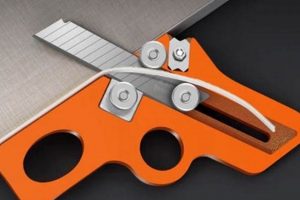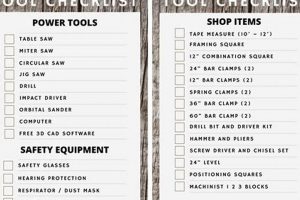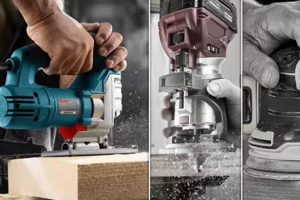The phrase signifies implements and equipment utilized for shaping, cutting, and assembling wood within a specific geographic location. It encompasses a range of hand tools, power tools, and machinery employed by carpenters, hobbyists, and professional woodworkers in the region. Examples include saws, drills, lathes, and sanders available from local suppliers.
Access to appropriate instruments is vital for successful woodworking projects. Reliable suppliers ensure quality craftsmanship and project longevity. Historically, San Diego’s proximity to timber resources and a thriving construction industry have fostered a demand for these essential resources. The availability of suitable equipment enables both artistic expression and practical applications within the local community.
This article will examine the categories of such implements, detail their typical applications, and provide insights into selecting the most appropriate tools for specific tasks within the San Diego area. Further sections will cover local suppliers, safety considerations, and maintenance best practices.
Selecting Optimal Equipment
This section provides guidance on procuring and utilizing woodworking instruments, particularly within the context of the San Diego market. Consideration of these points can lead to increased efficiency and project success.
Tip 1: Assess Project Requirements: Before acquisition, determine the specific tasks required for the project. This will dictate the necessary tools. For example, intricate joinery requires precision instruments, while large-scale construction necessitates robust power tools.
Tip 2: Evaluate Tool Quality: Prioritize durability and precision. Investing in high-quality tools ensures longevity and accurate results. Consider reputable brands and user reviews to gauge performance.
Tip 3: Consider Ergonomics: Prolonged woodworking can be physically demanding. Select tools with comfortable grips and balanced weight distribution to minimize strain. Prioritize instruments designed for prolonged use.
Tip 4: Research Local Suppliers: San Diego offers a variety of vendors. Compare pricing, selection, and customer service. Establish relationships with suppliers who provide knowledgeable support.
Tip 5: Prioritize Safety Equipment: Protective eyewear, hearing protection, and dust masks are essential. These items mitigate risks associated with woodworking operations. Ensure proper fit and functionality.
Tip 6: Implement Regular Maintenance: Proper care extends the lifespan of implements. Clean tools after each use, sharpen blades regularly, and lubricate moving parts. Adherence to manufacturer’s instructions is crucial.
Tip 7: Seek Educational Opportunities: Local woodworking classes and workshops provide valuable training. Learning proper techniques enhances skill and reduces the risk of injury. San Diego offers various avenues for woodworking education.
By adhering to these guidelines, individuals can effectively select and maintain woodworking instruments, leading to improved project outcomes and a safer working environment.
The subsequent section will address specific tool categories and their respective applications in greater detail.
1. Local Suppliers
The availability of tools within the San Diego area is directly influenced by its network of suppliers. These entities serve as the primary point of access for woodworkers, impacting tool selection, pricing, and the overall woodworking experience.
- Inventory Diversity
Local suppliers offer a range of equipment, from basic hand tools to specialized machinery. This diversity caters to varying skill levels and project complexities. A well-stocked supplier allows woodworkers to find the specific instrument they require without resorting to distant vendors or online retailers. For example, a San Diego cabinet maker could source a specific type of router bit from a local store ensuring timely completion of their project.
- Expertise and Support
Local suppliers often possess specialized knowledge about different tool types and their applications. This expertise is invaluable for woodworkers seeking advice on tool selection, maintenance, or troubleshooting. This support can be especially beneficial for novice woodworkers who may lack experience in choosing the appropriate tools for their projects. An example would be a local supplier guiding a beginner on selecting their first set of chisels, recommending appropriate sizes and steel types based on the woodworker’s planned projects.
- Community Engagement
Local suppliers frequently engage with the San Diego woodworking community through workshops, demonstrations, and partnerships with local woodworking clubs. This involvement fosters a sense of community and provides opportunities for woodworkers to learn new skills and network with peers. This engagement can include the suppliers hosting workshops on techniques, tool safety, or material selection, and sponsoring local woodworking competitions.
- Price and Availability
Local suppliers can offer competitive pricing and immediate availability, factors which are crucial for time-sensitive projects. While online retailers may offer lower prices on some items, shipping costs and delays can offset these savings. The proximity to the San Diego woodworking community allows for a streamlined supply chain, reducing lead times and minimizing logistical challenges. This includes offering convenient pick up or delivery options for local woodworkers, enabling them to quickly and easily obtain the tools they need to keep their projects moving forward.
The presence and efficacy of local suppliers are integral to the woodworking landscape in San Diego. The connection between the tool availability, the expertise offered, community support, and pricing demonstrates the benefits of supporting local business in that area, and how that positively affects the woodworking craft and it’s community.
2. Tool Categories
The classification of implements significantly impacts the San Diego woodworking community. Categorization allows for organized purchasing, efficient workshop setup, and targeted skill development. Without a structured understanding of tool categories, woodworkers face challenges in selecting the appropriate instruments for specific tasks, potentially leading to inefficient workflows, compromised project quality, and increased risk of injury. For example, a San Diego furniture maker specializing in mid-century modern designs requires a distinct set of tools compared to a craftsman focused on maritime woodworking. Identifying these divergent needs necessitates a clear understanding of categories like hand tools (chisels, planes, saws), power tools (routers, sanders, jointers), and measuring/layout tools (squares, levels, marking gauges).
Different project needs dictate the proper category tools required. The availability of specific types of tools in local San Diego suppliers directly influences the possibilities of what the local craftspeople can accomplish. Specialized categories such as carving tools, turning tools (for lathe work), or finishing tools further illustrate the impact. Consider a San Diego luthier who needs specialized bending irons and thickness sanders to complete his guitars. A local store that carries these specialized tools allows the craftsperson to more easily complete the instruments.
Categorizing allows for a more in depth selection of specialized tools. Proper utilization of tool categories improves safety, efficiency, and project success. By understanding the role of different tool types and their correct application, woodworkers in San Diego can effectively manage their workshops and bring their creative visions to life. A well-defined awareness of tool categories directly supports the flourishing woodworking community in San Diego, aiding both amateur and professional woodworkers.
3. Safety Measures
The safe operation of implements is paramount within the San Diego woodworking environment. Injuries resulting from improper tool use can have significant consequences, impacting both individual well-being and professional productivity. Understanding and implementing appropriate safety protocols directly mitigates these risks. The connection between safety measures and available tools is cause and effect. When proper safety equipment is unavailable or when tools are used incorrectly due to lack of safety information, accidents happen.
The availability of woodworking equipment from local San Diego suppliers is intrinsically linked to safety considerations. Reputable vendors often provide safety guidelines and product demonstrations, promoting responsible tool use. Moreover, the selection of specific tools should be guided by safety features, such as blade guards, dust collection systems, and ergonomic designs. As an example, a local San Diego high school shop class, using outdated equipment without proper dust collection, can increase students risks of respiratory illnesses. Conversely, a woodworking business that invests in modern equipment will ensure that employee accidents are limited.
Ultimately, prioritizing safety in the use of shaping implements fosters a sustainable and responsible woodworking practice within San Diego. This necessitates continuous education, adherence to established safety protocols, and a proactive approach to identifying and mitigating potential hazards. Ignoring proper safety practices leads to risks, which can cause bodily harm. Adherence to safety guidelines improves the woodworking craft. Ensuring the well-being of woodworkers directly contributes to the continued vitality of the San Diego woodworking community.
4. Maintenance Needs
The operational longevity and precision of implements within the San Diego woodworking community are directly correlated with consistent and appropriate upkeep. Neglecting maintenance results in diminished performance, increased risk of malfunction, and a shortened lifespan for tools, thus representing a significant economic and functional consideration. As such, integrating maintenance protocols into the lifecycle of these devices is not merely an option but a practical necessity. The cause-and-effect relationship is evident: inadequate maintenance leads to tool degradation, while proper maintenance preserves tool functionality and extends their useful life. As an example, the failure to regularly sharpen the blades of a jointer owned by a San Diego furniture maker results in rough, uneven cuts, ultimately compromising the quality of the finished product and increasing project completion time.
The importance of proper maintenance as a component of woodworking equipment use extends beyond mere functionality. It encompasses safety considerations, as dull blades or malfunctioning mechanisms increase the risk of accidents. Consider a San Diego hobbyist using a dull chisel; the increased force required to make a cut elevates the risk of slippage and potential injury. Practical applications of this understanding are numerous, ranging from implementing regular cleaning schedules to adhering to manufacturer-recommended maintenance procedures. Another instance is a San Diego construction company’s maintenance schedule for its power saws. If the saws are not checked regularly for blade wear or alignment, they will quickly become a safety hazard.
In summary, the maintenance of implements is integral to the success and safety of woodworking endeavors within San Diego. Neglecting upkeep results in diminished tool performance, increased risk of accidents, and reduced tool lifespan. Embracing a proactive maintenance strategy ensures optimal tool functionality, enhances project quality, and contributes to a safer and more productive woodworking environment. The challenge for the San Diego woodworking community lies in consistently implementing these maintenance practices across diverse user groups, from professional contractors to amateur hobbyists.
5. Project Suitability
The selection of woodworking implements in San Diego is inextricably linked to the intended project. Project suitability serves as the primary determinant in choosing the appropriate tools, as each undertaking necessitates a specific range of instruments to achieve desired outcomes. A disconnect between tool selection and project requirements leads to inefficiencies, compromised quality, and potential project failure. The relationship manifests as a clear cause and effect: selecting unsuitable equipment results in substandard workmanship, while employing appropriate tools facilitates efficient and high-quality results. For example, using a hand saw for a task requiring the precision of a table saw, like creating perfectly square cabinet components for a San Diego kitchen remodel, will likely yield inaccurate cuts and structural instability.
Project suitability as a critical component of equipment choice extends beyond mere functionality. It encompasses factors such as scale, material, and desired finish. Larger projects often necessitate power tools and heavy machinery, while smaller, more delicate projects may be better suited for hand tools. The type of wood used also dictates the necessary implements. Hardwoods require more robust cutting tools than softwoods. Similarly, achieving a specific finish may require specialized sanding or spraying equipment. Consider a San Diego artisan crafting a custom surfboard from balsa wood; the choice of hand planes and sanding blocks will differ significantly from those used to build a redwood deck. Practical applications include consulting project plans, material specifications, and desired aesthetic outcomes before acquiring any woodworking equipment. Assessing the scope of the project and the nature of its components helps to define the tool requirements, thereby enabling a more efficient and effective workflow.
In conclusion, project suitability is the cornerstone of informed equipment selection within the San Diego woodworking community. Failure to consider the specific demands of a project can result in diminished quality, wasted resources, and potential frustration. Emphasizing the symbiotic relationship between project needs and tool capabilities fosters a more skilled, efficient, and ultimately successful woodworking practice. The continuing challenge lies in educating woodworkers, from hobbyists to professionals, on the importance of thoroughly assessing project requirements before investing in equipment, ensuring that the chosen tools are optimally suited for the intended task.
Frequently Asked Questions
This section addresses common inquiries regarding the acquisition, utilization, and maintenance of instruments for shaping wood within the San Diego area. The intent is to provide concise and informative answers to frequently encountered questions.
Question 1: What factors determine the ideal instruments for a specific project in San Diego?
Project scale, material type, precision requirements, and desired finish significantly influence instrument selection. Larger projects often necessitate power tools, while intricate work benefits from hand tools. Hardwoods demand more robust cutting instruments than softwoods.
Question 2: Where can quality instruments be sourced within the San Diego region?
San Diego offers a range of suppliers, from large hardware stores to specialized woodworking shops. Online retailers also provide options, but local vendors often offer valuable expertise and immediate availability.
Question 3: What are essential safety precautions when operating woodworking implements?
Eye protection, hearing protection, and dust masks are mandatory. Ensure proper training on tool operation and adhere to all manufacturer-recommended safety guidelines. Regular inspection and maintenance of equipment are also crucial.
Question 4: How frequently should instruments undergo maintenance procedures?
Maintenance frequency depends on tool usage and type. High-use tools require more frequent attention. Sharpening blades, lubricating moving parts, and cleaning after each use are generally recommended.
Question 5: What resources are available for woodworking education and skill development in San Diego?
Various community colleges, woodworking clubs, and private instructors offer courses and workshops. Online tutorials and instructional videos also provide supplementary learning resources.
Question 6: How does climate affect wooden equipment in San Diego?
San Diego’s climate, characterized by relatively low humidity, can lead to wood shrinkage and potential tool loosening. Proper storage and humidity control are essential to maintain tool integrity. Metal components may also be subject to corrosion, necessitating regular cleaning and lubrication.
The answers provided offer a foundational understanding of key considerations regarding woodworking tools within the San Diego context. Adherence to these principles promotes safe, efficient, and successful woodworking practices.
The following section will delve into case studies illustrating practical applications of woodworking principles within the local environment.
Conclusion
This exploration has outlined the core considerations relevant to woodworking tools in San Diego. Factors from supplier selection and tool categorization to safety protocols, maintenance needs, and project suitability have been addressed. The availability of appropriate equipment, coupled with skilled application and diligent upkeep, is critical for successful woodworking endeavors within the region.
The ongoing commitment to proper tool selection, safe operating procedures, and consistent maintenance will sustain the craft and ensure the continued vitality of the San Diego woodworking community. Further research and practical application of the principles outlined herein are encouraged for both professional and hobbyist woodworkers.







